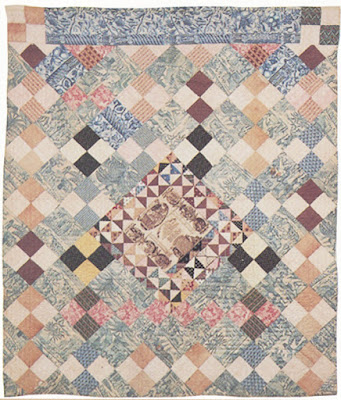Panel #1
What exactly are we discussing here at Chintz Panel Quilts? We have a definition we agree upon and we thought we'd clarify it by explaining what we are NOT gathering information on.
One of our first definitions is "chintz"---a multicolored print.
Panel #3
Trophy of Arms
Many of the panels we find are printed in what was called full chintz or whole chintz style with
pink, red, blue, green, orange, yellow, brown and purple on a white ground. The purples might fade to brown; the greens to blue.
Others like Panel #13 are more limited in color.
Was the blue ever green? The brown ever purple?
Probably not.
A toile about how toiles are printed, by Jean Baptiste Huet (1745-1811)
Multi-color chintzes are different from toiles, which today tends to mean a monochrome furnishing print with figures drawn in lines rather than shapes of color. Toiles originally were printed with large copper plates but by 1800 printers were experimenting with faster, simpler copper cylinders. It's a look rather than a process that defines toiles today.
Toile-style monochrome fruit basket print with
a short repeat indicating it was printed by roller rather
than plate.
We are NOT filing information on quilts with toiles. It's a bigger category and toile style bedcoverings go back earlier than chintz panel quilts.
The basket print above shows another style we do not keep track of here---yardage of continuous
images---NOT meant as decorating panels. Quilters may have cut the baskets out of this repeat design to use with Broderie-Perse style applique but we have never given this yardage a number. We need to keep the definition narrow because there is an enormous potential pool of clever seamstresses cutting panel-like applique from yardage.
A fashion for rococo scrolls offers many possibilities for fussy cutting.
Portuguese stripe from the Cooper-Hewitt collection
And then there are the Portuguese stripes with animals and urns.
Not going there either.
Some prints are on the fuzzy edges of our definition.
We are going to give this one a number and collect
examples of quilts where the wreaths are found.
A snapshot of a length of yardage featuring Panel #32. We don't have many photos of the repeats
but we believe this is how most of our panels were printed, meant to be cut and isolated rather than
used as yardage.
Medallion quilt, 72" x 60", About 1820.
Collected by Sally Casey Thayer about 100 years ago.
Collection of the Spencer Museum of Art
One style of panel-like textiles is single-color kerchiefs such as the one featured in this
small quilt possibly made for a child.
Years ago a curator at Spencer wrote to Florence Montgomery and asked for her opinion about this quilt. She was kind enough to answer (Barbara volunteers there) that the panel was a child's teaching handkerchief or bandana offering several moral lessons.
Here's the same handkerchief in red from the collection of
the Textile Museum of Canada.
Images include activities for good boys and bad boys like "Going to Church" and "Getting their Tasks" or "Idling with their Kite" and "Playing at Shufle Cap,"
Many handkerchiefs with pious advice were printed in the early 19th century. We hope someone, somewhere is giving each textile a number and filing every photo of the kerchief they can find.
But it is not us.
Our late friend Sue Hannah started a list of commemorative kerchiefs that Joyce Gross published in Quilters Journal decades ago. Early 19th-century monochromes include mourning panels, political textiles, Masonic kerchiefs, and celebrity prints.
We have records of antislavery handkerchiefs but have never seen one incorporated into a quilt.
An early quilt with an even earlier monochromatic Masonic bandana
at the Noah Webster house in Massachusetts
Similar style from the collection of the Winterthur Museum.
The central square features the U.S. Founders with Washington in the center.
Many Washington memorial textiles mourned his death in 1799, at a time when these monochrome panels were quite the fashion, commemorating everything from battles to British royal celebrations.
Some of the textiles are more like print broadsides.
This Washington panel offers an image of George Washington
as a truthful president, once considered a virtue.
The same printers who did newspapers and job printing
were probably responsible for these wordy textiles.
The Smithsonian's Treaty of Pilnitz quilt features a monochrome
kerchief in the center recalling an arcane agreement between
Prussia and the Holy Roman Empire in 1791.
Celebration of King George III's Golden Jubilee about 1810
from Dorothy Osler's book
Now this is what we are talking about! A multicolored image printed
in isolation, looking as if it was meant to be cut out and used in furnishings.
It has a number (#24) and a post:
If you want to read more about monochrome commemoratives the Smithsonian's long-out-of-print book Threads of History: Americana Recorded on Cloth by Herbert Ridgway Collins is a great source.
Here's a post from Barbara's 1812 Quilts blog about the early commemorative bandanas:
























No comments:
Post a Comment